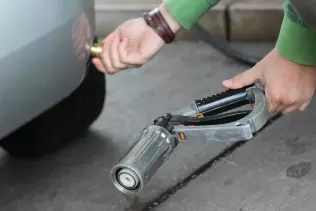- Main page
- Search
- Up to date
- Products
- Technology
- Vehicles
- Video
- Conversion Payback Simulator
Port Injection - Conversion Payback Simulator
Direct Injection - Conversion Payback Simulator
Diesel - Newsletter
 loading results...
loading results...
 © gazeo.comSelf-service autogas refueling is commonplace in Germany, like in most EU countries. Thanks to the prevailing Belgian (ACME) coupling standard, it's also easy and safe
© gazeo.comSelf-service autogas refueling is commonplace in Germany, like in most EU countries. Thanks to the prevailing Belgian (ACME) coupling standard, it's also easy and safeSo, without further ado, there are (as of January 2013) 494777 autogas-powered passenger cars in Goethe's fatherland. When categorised emission-wise, they prove quite eco-friendly, since quite a portion (266940 to be exact) complies with the Euro 4 standard. Incidentally, this is by 16562 more than a year earlier. The number of Euro 5-compliant cars rose nearly three-fold within the same period of time, from 11068 to 29498. The Euro 6 standard is a thing of the future, since only 5 (five!) cars had been registered until January 2013. Unless autogas systems for direct-injected engines become more common, little will change in that matter. As for Euro 3 and Euro 2 cars, there are still 36784 and 45427 of them on the roads, respectively. And even though old cars are scrapped and replaced by new ones, both numbers are on the up compared to January 2012.
Interestingly, not only passenger cars are LPG-powered in Germany. There are also 1923 campers, 119 motorcycles and 18 buses there, plus 9831 distribution and delivery vehicles, vast majority (8277) of them being light- to medium-duty vans with up to 1 tonne cargo capacity. Also, the statistics mention 109 agricultural tractors. Including all the above, the overall number of autogas-powered vehicles in Germany is 505538.
By looking at Germany's particular federate states it's easy to see where LPG is most popular as motor fuel, but then you have to remember they vary in size greatly – some of them are bigger than separate European countries, others are actually just single cities (even if they're quite large). So it comes as little surprise that North Rhine-Westphalia is the region with the greatest number of LPG-powered cars (163948). Lower Saxony (68245 cars) and Bavaria (56952) came in second and third, respectively. Regions with the fewest autogas vehicles are Hamburg (4944), Bremen (3192) and Saara (2923). Given the differences in area, the number of LPG cars per 1000 inhabitants criterion should prove more objective and it does, but it also changes little. North Rhine-Westphalia remains in the lead (9,18), while Hamburg and Saara are the ones most sparsely "populated” with LPG cars (2,72 and 2,9 vehicles per 1000 citizens). All in all, autogas-powered vehicles (of all sorts and categories) are 5,4 per cent of vehicles registered in Germany.
When it comes to ownership profile, cars running on LPG belong for the most part to private drivers. Only 4,6 per cent are owned by companies, whereas in the case of diesels the ratio is 22,9 per cent (for hybrids – 21,8%, for CNG cars – 26,4%, for EV's – as much as 75%). With half a million vehicles Germany has become a major European autogas market in what seems like no time at all, although there's still a lot of work to be done and many cars to be converted before Poland can be beaten with its 2,8 million LPG cars. We hope German market doesn't stall and keeps developing at a brisk pace. If not to overtake neighbouring countries, then at least to cut down on fuel costs and harmful emissions.






